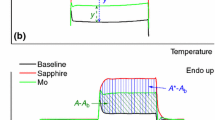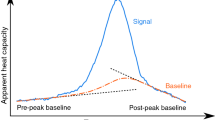Abstract
Reading and co-workers introduced a new technique a few years ago called Modulated Differential Scanning Calorimetry or MDSC. Here the first part of a theoretical analysis for this technique is given. A simple mathematical model for modulated differential scanning calorimetry in the form of an ordinary differential equation is derived. The model is analysed to find the effect of a kinetic event in the form of a chemical reaction. Some possible sources of error are discussed. A more sophisticated version of the model allowing for spatial variation in a calorimeter is developed and it is seen how it can be reduced to the earlier model. Some preliminary work on a phase change is also presented.
Similar content being viewed by others
Abbreviations
- a :
-
(remaining) mass fraction of reactant or crystalline material
- a 0 :
-
initial mass fraction
- b :
-
temperature ramp
- c :
-
specific heat capacity
- f :
-
rate of heat intake by a kinetic process within the sample
- g :
-
temperature-dependence function of a reaction rate
- h :
-
distribution function for molecular weights
- k :
-
thermal conductivity
- K a :
-
function appearing in the Avrami equation
- l :
-
length scale of a (one-dimensional) calorimeter
- l s :
-
half-width of a sample
- m :
-
complex spatial-decay rate of modulated temperature
- m j :
-
coefficients in a power series for α1 (j=1,2,...)
- n :
-
outward normal
- n j :
-
coefficients in a power series for α2 (j=1, 2,...)
- p :
-
order of a reaction
- q, q j :
-
coefficients appearing in expressions for\(\mathop \Delta \limits^ \sim \) T(j=C, S, D, 1, 2, 3, 4)
- r :
-
reaction rate
- r′ :
-
temperature derivative of reaction rate
- s :
-
time used in integrations
- s d :
-
dimensionless position of a free boundary
- s f :
-
position of a free boundary
- t :
-
time
- t 2 :
-
time scale of melting
- u :
-
real part ofw
- v :
-
imaginary part ofw
- w=wR, ws,W F :
-
functions of position determiningT
- W j :
-
coefficients in power seriesw (j=0, 1, 2...)
- x :
-
position within calorimeter or sample
- y :
-
dimensionless position
- zo,zR,zs:
-
functions of position determining¯T
- A :
-
pre-exponentional rate constant
- A * :
-
adjusted pre-exponential rate constant
- A + :
-
scaled pre-exponential rate constant
- A j :
-
coefficients appearing in expressions of cyclic temperature in regionj (j=1, 2, 3)
- B :
-
amplitude of modulation of temperature
- B :
-
complex amplitude of temperature (a complex multiple ofB)
- B j :
-
complex amplitude ofT j (j=F, R, S, RM or SM)
- C(T):
-
heat capacity of the sample when it depends up on temperature
- CR,CS:
-
heat capacities of pan and sample
- C j :
-
coefficients appearing in expressions of cyclic temperature in regionj(j=1, 2, 3)
- ¯C s :
-
value of sample's heat capacity given by underlying “measurement”
- C s :
-
value of sample's heat capacity given by cyclic “measurement”
- D :
-
heat capacity of sample regarding it as a function ofσ
- E :
-
activation energy
- F, G :
-
functions of time appearing in a nearly periodic signal
- FM,¯GM,GM:
-
“measured” versions ofF, G
- G a :
-
function appearing in the Avrami equation
- H :
-
heat of reaction
- I :
-
function of time appearing in a nearly periodic signal
- ĪM,ĪM:
-
“measured” versions ofI
- K :
-
effective heat-transfer coefficients
- Kt,K0,K1,K2:
-
internal heat-transfer coefficients
- L :
-
latent heat
- M :
-
mass of sample
- M j :
-
coefficients in expressions for\(\mathop \Delta \limits^ \sim \) T(j=1,2,3,4)
- N :
-
exponent appearing in the Avrami equation
- P :
-
coefficient appearing an\(\mathop \Delta \limits^ \sim \) T
- QR,Qs:
-
heat contents of reference pan, sample pan plus sample
- R :
-
gas constant
- S :
-
a surface
- S b :
-
cross-sectional area of a bar
- S c :
-
cross-sectional area of a sample
- S F :
-
external surfaces of calorimeter
- SR,Ss:
-
surfaces of reference and sample pans
- T :
-
temperature
- T :
-
scaled complex amplitude of modulated temperature
- Ti(x):
-
temperature on initiation of melting
- T c :
-
melting temperature
- T e :
-
external temperature
- TF,T R ,TS:
-
temperatures of furnace, reference, sample
- TRM,TSM:
-
temperatures measured for reference and sample
- T o :
-
initial temperature
- Ta,T1,T2:
-
typical temperatures
- T oj :
-
initial values ofT j(j=F, R, S, RM, SM)
- Toj,Tlj:
-
coefficients appearing in expressions for underlying temperature in regionj of a one-dimensional calorimeter (j=1,2,3)
- ΔT :
-
temperature difference,T R-T S
- ΔT j :
-
coefficients in a power series ofΔT (j= 0,1, 2,...)
- U :
-
dimensionless temperature based on reaction rate
- W :
-
molecular weight
- Z(W):
-
mass fraction with molecular weight ≤W
- α:
-
scaled amount of reactant
- αj :
-
surface integrals of normal derivatives ofw's (j=1,2,3)
- β:
-
spatial decay rate of modulated temperature
- γj :
-
surface integrals of normal derivatives of z's (j=1,2,3)
- δ:
-
dimensionless temperature over whichC(T) varies
- ɛ:
-
1/dimensionless activation energy
- ɛm :
-
Stefan number
- η:
-
error in measurement of temperatures due to location of thermo-couples
- λ:
-
degree of bias
- ρ:
-
density
- σ:
-
rescaled dimensionless temperature
- τ:
-
dimensionless time
- ϕ:
-
phase lag
- ϕb, ϕc :
-
baseline and corrected phase lags
- ϕs :
-
phase of alternative “reference” signal, e.g. furnace modulation
- ψ:
-
ratio indicating importance of ωC R compared withK (“departure from perfection”)
- θ:
-
dimensionless temperature
- θi :
-
dimensionless temperature on initiation of melting
- ω:
-
angular frequency of modulation of temperature
- Ω:
-
rescaled angular frequency
- -:
-
underlying part (notC's,F's,G's,I's)
- ∼:
-
cyclic part (notC's,F's,G's,I's)
- ':
-
derivative with respect to argument (notr)
References
M. Reading, D. Elliot, and V. L. Hill, “Some aspects of the theory and practice of modulated differential scanning calorimetry”, Proc. 21st North American Thermal Analysis Society Conference, 1992, p. 145–150.
M. Reading, Trends Polymer Sci., 1 (1993) 248.
M. Reading, A. Luget, and R. Wilson, Thermochim. Acta, 238 (1994).
M. Reading, R. Wilson and H. M. Pollock, in Proceedings of the 23rd North American Thermal Analysis Society Conference, 1994, p. 2–10.
B. Wunderlich, Y. Jin and A. Boiler, Thermochim. Acta, 238 (1994) 277.
J. Hatta, Jpn. J. Appl. Phys., 33 (1994) 686.
B. Wunderlich and A. Boiler, Abstract, 24th NATAS Conference, 1995.
J. E. K. Schawe, Thermochim. Acta, 261 (1995) 183.
S. M. Marcus and M. Reading, “Method and apparatus for thermal conductivity measurements”, U.S. Patent 5335993, 1994.
J. D. Murray, Asymptotic Analysis, Oxford University Press, 1973.
E. J. Hinch, Perturbation Methods, Cambridge University Press, 1991.
B. Wunderlich, A. Boller, I. Okazaki and S. Kreitmeier, Thermochim. Acta, 283 (1996) 143.
K. J. Jones, I. Kinshott, M. Reading, A. A. Lacey, C. Nikolopoulos and H. M. Pollock, “The origin and interpretation of the signals of MTDSC”, preprint.
S. Marcus, Private communication
M. H. Protter and H. F. Weinberger, Maximum principles in differential equations, Prentice-Hall, Englewood Cliff, N. J., 1967.
K. Nakamura, T. Watanebe, K. Katayama and T. Amano, J. Appl. Polym. Sci., 16 (1972) 1077.
K. Nakamura, K. Katayama and T. Amano, J. Appl. Polym. Sci., 17 (1973) 1031.
K. A. Q. O'Reilly and B. Cantor, Proc. Roy. Soc. Lon. A, 452 (1996) 2141.
J. Crank, Free and moving boundary problems, Oxford University Press, 1984.
Author information
Authors and Affiliations
Additional information
Dedicated to Prof. Menachem Steinberg on the occasion of his 65th birthday
Rights and permissions
About this article
Cite this article
Lacey, A.A., Nikolopoulos, C. & Reading, M. A mathematical model for Modulated Differential Scanning Calorimetry. Journal of Thermal Analysis 50, 279–333 (1997). https://doi.org/10.1007/BF01979568
Issue Date:
DOI: https://doi.org/10.1007/BF01979568




